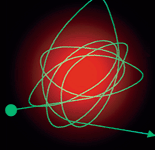Like a tiny cartoon superhero taking on a huge bully, a photon grabs a passing atom and whirls it in erratic loops.

Experiments using a new device that creates this action scene demonstrate for the first time that a single photon can trap and control an atom, says Christina J. Hood of the California Institute of Technology in Pasadena. The device permits only one photon at any time, on average, into a minuscule cavity between two small mirrors.
The photon manipulates the atom by quantum mechanical means, giving scientists a unique window on the quantum interactions between an atom and a lone photon, Hood says.
The achievement promises to aid the development of practical quantum devices for computing and telecommunications (SN: 4/3/99, p. 220), and it could launch a new type of microscopy, she says.
In the Feb. 25 Science, Hood and her colleagues explain how they used extremely reflective, 1-millimeter-diameter mirrors attached to small wedges of glass. They placed a pair of the concave mirrors about 11 micrometers apart to create a cavity and enclosed the setup in a vacuum chamber.
Inside the cavity, weak illumination by a laser beam creates a complex electric field made up of disk-shape segments packed like quarters in a coin roll. This elaborate field is the work of a single photon, on average. When the researchers dropped an ultracold cesium atom into a segment, the field forced the atom to orbit the center of the segment, typically a few times.
Besides trapping and controlling atoms, the cavity enables researchers to observe atomic motion. As each photon eventually leaks out through the mirrors, another takes its place. From variations in intensity of the escaping light, the scientists reconstruct the cesium atom’s path.
A future version of this “atom-cavity microscope” should be able to track fast contortions and reactions of molecules as well, the researchers say.







